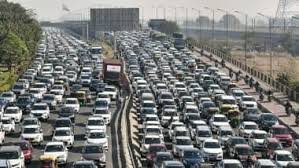Mumbai Traffic News: MMRDA to Remove BKC G Block Cycle Track for 3+3 Lane Upgrade, Aims to Cut Travel Time by 40%
By Lokmat Times Desk | Updated: August 12, 2025 15:30 IST2025-08-12T15:25:55+5:302025-08-12T15:30:45+5:30
Addressing persistent traffic bottlenecks faced by commuters in Bandra-Kurla Complex (BKC), the Mumbai Metropolitan Region Development Authority (MMRDA) has ...

Mumbai Traffic News: MMRDA to Remove BKC G Block Cycle Track for 3+3 Lane Upgrade, Aims to Cut Travel Time by 40%
Addressing persistent traffic bottlenecks faced by commuters in Bandra-Kurla Complex (BKC), the Mumbai Metropolitan Region Development Authority (MMRDA) has initiated the removal of the cycle track in G Block. This move has sparked mixed reactions—some expect smoother traffic flow, while others doubt any significant change. The cycle track project began in 2011, with plans for a 13 km stretch costing about ₹60 crore. By 2021, approximately 9 km had been completed, as reported by media outlets. However, despite the substantial investment, the facility remained underutilized, often misappropriated for illegal parking by two-wheelers and auto-rickshaws.
From cycle track to extra vehicular lanes
The worsening traffic congestion in BKC—made worse by road closures like the Sion bridge shutdown—has prompted authorities to repurpose the cycle track. Starting August 2025, MMRDA will convert the space into additional vehicular lanes, expanding the current 2+2 configuration into 3+3 lanes. According to reports from the Times of India and The Indian Express, the change is expected to cut peak-hour travel times from about 25 minutes to 15 minutes. Signal waiting times could reduce from 10 to 7 minutes, and idling-related CO₂ emissions are projected to drop by over 30%.
Why BKC draws massive daily traffic
Bandra-Kurla Complex stands as Mumbai’s prime commercial hub, housing corporate headquarters, foreign consulates, cultural spaces, luxury hotels, fine-dining restaurants, and upscale malls. Its strategic location—between Bandra and Kurla, and close to both Eastern and Western Express Highways—makes it highly accessible and attractive for businesses. Every day, over 2.5 lakh people travel to the area for work, meetings, or leisure. This high volume, coupled with limited road capacity, intensifies congestion. The G Block corporate zone, the Income Tax junction, and the MTNL junction are among the most problematic choke points, especially during peak office hours.
Traffic challenges and hotspots
Navigating certain stretches within BKC can be particularly frustrating during rush hours. A 4-5 km journey in these areas can take as long as 45 minutes, with morning and evening peak hours proving most challenging. Heavy vehicle density, signal delays, and roadside parking further aggravate the issue. The G Block area—home to numerous office towers—is one of the worst affected, with vehicles frequently crawling at walking pace. While traffic police and wardens attempt to regulate the flow, the sheer number of vehicles often overwhelms these efforts, leading to long queues and delays across the complex.
Also Read: Maharashtra Holiday on Janmashtami 2025? Here’s What You Need to Know
Public transport and accessibility issues
BKC’s public transport connectivity remains limited. The under-construction Metro Line 2B (DN Nagar–Mandale) will pass through the area, with partial openings expected in 2026. The operational Mumbai Metro Line 3 (Colaba–Bandra–SEEPZ) includes an underground BKC station, but last-mile connectivity is still inadequate. The nearest suburban railway stations—Bandra (W), Kurla (E), and Santacruz—are connected by auto-rickshaws, shared cabs, and app-based taxis, though commuters often complain of high fares and unavailability during rush hours. Walking and cycling are inconvenient due to broken footpaths, while only a few bus routes directly serve the business district.
Driving and parking constraints in BKC
Despite the congestion, private cars remain the most preferred mode of travel to BKC. Parking, however, is both scarce and costly. Although multi-level parking structures exist, they are often filled to capacity by 10 am, forcing latecomers to hunt for roadside spots or pay premium rates in private lots. On-street parking, legal or otherwise, clogs already narrow lanes, further slowing traffic. While the removal of the cycle track aims to create more driving space, experts note that without improvements in public transport and parking management, the relief could be temporary, as increased road capacity may simply attract more vehicles.